The History of Money Revolves Around Gold
Posted on — Leave a commentMoney makes the world go round.
But, what is money?
That $20 bill in your wallet is money. Throughout history, cowrie shells, barley, even peppercorns have been used as money. Do any of these things actually have intrinsic or real value? One could argue no.
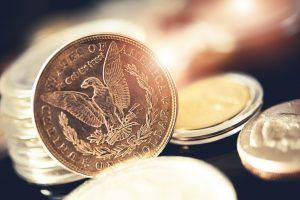
What gives things like paper money, the $5, $10, and $20 dollar bills you get from the bank value? It’s the backing and promises by the U.S. government that this has value. Essentially, American society is built around the agreement that this paper money has value.
For the vast majority of human history, however, people relied on gold and silver as money.
The traditional definition of money states that it is a:
- Store of value, which means people can save it and use it later
- Unit of account, which provides a common base for prices
- Medium of exchange, something that people can use to buy and sell with
“Precious metals seemed to serve all three needs: a stable unit of account, a durable store of value, and a convenient medium of exchange,” according to an International Monetary Fund blog post.
Precious metals are hard to obtain. There is a finite supply of them in the world. They stand up to time well. They are easily divisible into standardized coins and do not lose value when made into smaller units. In short, their durability, limited supply, high replacement cost, and portability made precious metals more attractive as money than other goods, the IMF said.
Gold coins were first created by King Croesus of Lydia, now part of Turkey, around 550 BC and circulated in many countries before paper money was created.
When paper money was first printed it was tied and backed by gold.
As the American economy developed, a strong tradition of gold as money unfolded.
In 1913, the Federal Reserve Act provided for the creation of Federal Reserve banks and a system overseen by the Federal Reserve Board. U.S. law required the Federal Reserve to hold gold equal to 40 percent of the value of the currency it issued. The Federal Reserve Notes were convertible into gold at the fixed price of $20.67 per ounce.
In 1933, a financial crisis spurred Americans to convert their paper money for gold, which sparked a massive outflow of gold from the Federal Reserve.
Individuals wanted real physical gold. Not paper money. A rush on the banks began.
In March 1933, the Federal Reserve Bank of New York could no longer honor its commitment to convert paper money to gold and President Franklin D. Roosevelt declared a banking holiday.
Ultimately, President Roosevelt issued an Executive Order requiring all Americans to surrender all gold owned by them to a Federal Reserve bank and prohibited the private holdings of all gold coins and bullion.
Blanchard and Company has deep roots in gold’s history in America.
Decades after President Franklin D. Roosevelt prohibited private U.S. citizens from owning gold, one of our company’s founders – Jim Blanchard – rose to prominence as a supporter of American’s right to own gold in the early 1970s.
He gained national attention when he arranged for a biplane to tow a banner proclaiming “Legalize Gold” over President Richard Nixon’s inauguration in January 1973.
His lobbying efforts were a success and after more than 40 years, Congress once again legalized private ownership of gold bullion effective Dec. 31, 1974. Once the gold restrictions were lifted, Blanchard founded our company in 1975 and helped build it into of the nations largest and most respected tangible asset investments firms.
Owning gold and other precious metals makes as much sense today as it did a thousand years ago, perhaps even more so given the changes that have occurred on a governmental and monetary policy level. Diversification in tangible assets makes sense for all investors for a small portion of their portfolio in order to preserve and grow wealth.
As history shows, gold was the world’s first currency and may remain the only true currency available today. Why own it? Check out this compelling research from Penn State University professors on how gold improves portfolio performance, download it free here.
One of the Boldest Campaigns in History
Posted on — Leave a commentIt was one of the boldest campaigns in history: the conquering of the mighty Inca Empire.
And who led it? An illiterate man born in poverty, the illegitimate son of a soldier and a servant. What drove him and his men was an insatiable desire for gold.
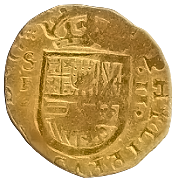
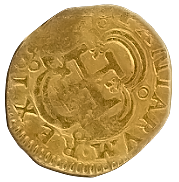
The Incas called gold “the tears wept by the sun,” and they used it for ornamentation. The golden temple of Coricancha, for example, was filled with gold, with one room containing a giant sun disc that reflected sunlight to illuminate the rest of the temple. The disc was even aligned so that during the summer solstice, it illuminated a place where only the emperor was allowed to sit. When the Spanish took Cusco, they destroyed most of Coricancha and melted down the gold plating and sculptures to send back to Spain.
From that and mints in the New World, the Spanish sent gold back to Europe in quantities the continent had never seen. And on those voyages, one of the treasures that pirates risked their lives for was the gold cob: coin of an empire.
All known examples of this coin came from the shipwrecks of the Santa Margarita and the Nuestra Señora de Atocha. Both sailed with the 1622 treasure fleet and sank off the coast of Florida.
Today we bring you a beautiful specimen of one of those cobs: a 1622 gold escudo. This 1622 gold escudo was the first gold coin struck in the New World. Gold escudos were introduced by Spain in the 16th century and became the nation’s primary gold currency. They were minted in Madrid and Seville, as well as in several of Spain’s colonies.
Cobs are coins that were struck and trimmed by hand. When you handle a gold cob, you thus hold in your hand the handiwork of a 17th-century minter: someone who struck your coin 400 years ago.
Want to read more great rare coin stories? Sign up for our newsletter! In addition to numismatic news, you’ll get weekly updates with the latest market news and investment advice.
The Three Factors Influencing Gold Now
Posted on — Leave a commentAs we make our way through the second half of 2019 several factors are influencing gold. The World Gold Council has reported on these characteristics and in this post, we break down each one. We will examine why they are important and what they might mean for investors.

Global Monetary Policy and Interest Rates
Until recently interest rates were on the rise and expected to continue their increase. However, in just the past few days we have seen a reversal of this trend. The Federal Reserve cut interest rates for the first time in over ten years. Reserve Chairman Jerome Powell explained his reasons for the cut by citing growing trade tensions and a slowdown in global growth. As Gary Richard, professor of economics at the University of California, remarked “The Federal Reserve has generally better information about the economy than most of the public, and they have a lot of experts there – they’re trying to predict the future. And the Fed is acting now as if we’re in a recession.” For many, that is a frightening prospect.
Moreover, this fear of a contraction in the economy is shared abroad. The European Central Bank’s (ECB) President announced his intention to cut interest rates. Many expect the Bank of Japan to do the same. While a slowing global economy presents some problems it also presents some opportunities. As the World Gold Council remarks, “Our research indicates that the gold price was higher in the 12 months following the end of a tightening cycle.” They continue, “historical gold returns are more than twice their long-term average during periods of negative real rates – like the one we are likely to see later this year.”
Balancing Risk
This low interest environment has spurred a significant amount of the stock market’s rally in the last six months. This dynamic is a problem because it means that heightened valuations are the result of stimulus measures rather than strong underlying fundamentals. Additionally, equity growth from interest rate cutting cannot be sustained. At some point there will be nothing left to cut. Investors are entering a playing field in which they need to diversify risk. As the World Gold Council points out, bonds have traditionally served this need with their more favorable risk profile. However, as yields fall, prices are increasing and “70% of all developed market debt is trading with negative real yields with the remaining 30% close to or below 1%, according to their analysis.”
This scenario underscores the value of gold as a risk hedge when other traditional equity hedges, like bonds, become less attractive. As we have explored in previous posts, gold, as a universally accepted currency, has qualities not shared by asset classes like stocks and bonds.
Long-Term Structural Support
Gold demand in countries like China, and India will remain important to gold investors. While there are some signs that consumer demand will soften within the next several months, there are structural reforms in place in both countries which present a favorable long-term picture for gold. A broad ecosystem for trading gold is shaping this reform. With such systems in place it becomes easier, and more efficient to buy and sell gold. Moreover, economic policies that help broaden the middle class will drive gold purchases in the future as the precious metal becomes available to more citizens in some of the most populous countries in the world.
Interested in learning more? Sign up for our newsletter and get weekly updates on precious metals investing, rare coin news and great stories!
Four Factors That Can Drive Gold Higher In the Second Half
Posted on — Leave a commentFour Factors That Can Drive Gold Higher In the Second Half
Gold is on a tear, up 13% already in 2019. Many believe this rally is just getting started. Here are 4 reasons gold is expected to continue climbing in the second half of the year.

- Don’t Fight the Fed
There is an old saying – “Don’t Fight the Fed.” For precious metals investors, that translates into higher prices ahead. The Federal Reserve is expected to slash interest rates this week and with up to 100 basis points in rate cuts over the next year. Lower interest rates historically translate into higher gold prices.
In some countries – like Germany – government debt there now comes with a negative interest rate. Negative yields mean investors lose money on their investment. Not a great proposition. Negative interest rates boost interest in gold world-wide as a traditional store of value.
- Central Banks Buy Gold with a Vengeance
Last year, global central banks purchased more gold than at any time since the early 1970’s. This year? Central banks are still buying gold. Lots and lots of gold.
- “In 2018 alone, central banks bought 651 tonnes of gold, up 74% compared to 2017 and the highest level since 1971,” according to the World Gold Council’s Gold Hub.
Russia, China, Hungary, Poland, Egypt and India are a few of the countries who are consistently buying gold. In the first quarter of 2019, central banks added another 90 tonnes of gold to their coffers.
In late July, the World Gold Council published its 2019 Central Bank Gold Reserves (CBGR) survey. This survey revealed “continued robust central bank demand for gold in the short and medium term. 11% of emerging market and developing economy (EMDE) central banks surveyed say they intend to increase their gold reserves over the next 12 months.” That keeps a strong demand element in place for gold, which supports higher prices ahead.
- Investment Demand is Strong
Investors are piling into gold and momentum is strong. The yellow metal has climbed 13% since the close of 2018 and many Wall Street experts say the bull market is just getting started.
Individual investors are turning to gold because it is a well-documented safe-haven asset, with no counterparty risk when you buy physical bullion. It’s safe, easy to buy and sell and offers investors a return, especially during periods of financial market instability or crisis.
Billionaire investor Ray Dalio wrote in July in a LinkedIN post: “I believe that it would be both risk-reducing and return-enhancing to consider adding gold to one’s portfolio.”
“[W]e believe there is a very good chance that this marks the beginning of a new gold bull market,” Joe Foster, portfolio manager for the VanEck International Investors Gold Fund Foster told TheStreet in a July article. Foster says the gold run is “likely to last several years.”
- Geopolitical Uncertainty
Recent military and political tensions between the U.S. and Iran are only one cloud on the global geopolitical horizon, which could send gold shooting higher. The China – U.S. Trade War talks are still a big unknown for both the global economy and interactions between the world’s two biggest economies. Last but not least, while we’ve been hearing about “Brexit” for years now, the UK still could leave the European Union this fall which could trigger a major financial market upheaval. In uncertain times, investors pile into gold.
The Bottom Line
People buy life insurance, health insurance and car insurance. Gold is insurance for your portfolio, your assets and your wealth. Do you own enough?
Want to learn more about growing your wealth? You can take a look at our diversification strategy here and sign up for our newsletter. You’ll get great information on not only investments, but great rare coin stories, all delivered to your inbox.
The Second Life of the 1904-05 Lewis & Clark Exposition Gold Dollar
Posted on — Leave a commentThe United States expanded its reach in 1803 with the Louisiana Purchase. For $15 million the U.S. acquired 828,000 square miles from France. The additional land doubled the size of the country. Soon after, President Thomas Jefferson took the initiative to find out what awaited in that great wilderness. There were stories of mammoths, and towering salt mountains.
Jefferson tapped his private secretary Meriwether Lewis to mount an expedition into the region. Lewis solicited help from William Clark, a former Army lieutenant. Their journey from present day Pittsburgh to the Pacific Coast ended in 1806. Together the men were successful in mapping the topography of the terrain and collecting plant and mineral samples. They also discovered American Indian tribes and learned about their customs and language.
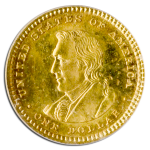
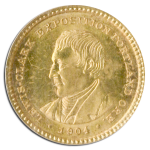
Nearly 100 years later citizens of Oregon made a proposal to honor the explorers. Their plans called for a fair to be held in the city of Portland which represented a portion of Lewis and Clark’s route. By 1904 the organizers were finally successful in securing Federal funding in the form of an appropriations bill which allocated $500,000 to the project. The bill also authorized minting a gold dollar to commemorate the fair. Charles E. Barber, the Mint Chief Engraver, was responsible for designing the coin.
It is believed that the inspiration for the profiles of both Lewis and Clark came from portraits of both men painted by Charles Willson Peale. Clark is on one side and Lewis is on the other. With each piece consisting of 90% gold, and 10% copper. The Philadelphia Mint struck approximately 60,000 pieces from 1904 to 1905, however, just over 40,000 were melted.
The fair began in the summer of 1905 drawing a total of two and a half million people. The coin was designed not only to commemorate the intrepid journey of Lewis and Clark, but also to finance the completion of a Sacagawea statue in Portland’s Washington Park. Unfortunately, the coins were unpopular with collectors at the time of their issuance. Over time, however, this lack of interest has made the Lewis and Clark Exposition gold dollar more valuable. For example, the 1904 coin can command a price anywhere from $900 to $10,000 depending on its condition according to A Guide Book of United States Coins. In fact, a near perfect 1904 coin claimed $57,500 in a 2006 auction. The 1905 coin is worth an estimated $1,200 to $15,000.
Many believe each of the two coins (1904, and 1905) only sold approximately 10,000 pieces each. The coins did, fortunately, sell well enough to successfully finance the completion of the Sacagawea statue. The story of the Lewis and Clark Exposition gold dollar is a reminder that commemorative coins often have a second life. In fact, those that are initially ignored later become rare, sought after pieces because of their scarcity. As with many coins that were unpopular, the Lewis and Clark gold dollar pieces were often incorporated into jewelry like broaches and stickpins. These uses for the coin only further diminished their availability in the secondary market.
The First Official U.S. Dollar Coin
Posted on — Leave a commentWhat an embarrassment.

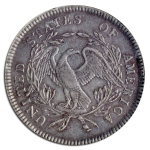
Americans used to use foreign money because we didn’t have our own.
In early America, we had no official coinage, and so we used a variety of foreign coins, including Spanish dollars.
In the 1780s, many prominent Americans began calling for the creation of a national mint. After the Constitution was ratified (giving Congress the power to coin money), Congress began reviewing the country’s monetary system and coinage and deciding what to do next. Treasury Secretary Alexander Hamilton recommended modeling our dollar on the Spanish dollar, and that’s what we went with.
In 1791, Congress authorized a mint. Three years later, engraver Robert Scot began working on the design for the dollar, which had Liberty on one side and an eagle on the other, as mandated by the Coinage Act. Extra care was taken with engraving the dollar compared to other denominations, because the U.S. knew this large coin would be heavily scrutinized when released and used abroad. This coin would represent our fledgling country, and we wanted it to do a good job.
However, the “Flowing Hair” design by Scot was short lived, as there were problems with the striking process … and a lack of enthusiasm for the design.
It’s actually kind of quaint. A relic of a bygone era, if you will (literally) …
The Flowing Hair Dollar was only minted for two years, making it quite rare.
Each coin in our catalog of rare coins tells its own story. If you want to read more, sign up for our newsletter here!
Silver Explodes To New 2019 High
Posted on — Leave a commentSilver soared to a new 2019 high last week as investors around the globe poured money into the metal.
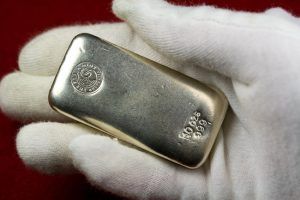
With gold prices up nearly 10% year-to-date, investors see opportunity in silver, which lagged gold in recent month.
Some Wall Street experts pointed to the recent swift decline in bitcoin, which sank from $12,647 on July 9 to a recent low at $9,575 on July 16, as a driving force for the huge up move into silver.
Both silver and gold, along with the Swiss Franc, are viewed by investors world-wide as a traditional safe-haven investments. They typically climb during periods of declining interest rates, political or military conflict or geopolitical tensions. Precious metals also typically gain sharply when stock market’s sell-off.
Some investors view bitcoin as another safe-haven alternative. But, recent volatility and swift dumping of bitcoin in July has many re-thinking that view. Bitcoin fell swiftly in part during Congressional hearings on Facebooks Libra project – another new cryptocurrency. Uncertainty around the future of cryptocurrency regulation sent Bitcoin sharply lower and in turn sent silver sharply higher, which is an important positive development for the metal.
As we’ve written about before, the Gold/Silver ratio has been historically out of whack this year.
In recent weeks, the gold/silver ratio hit 92.
Historically, readings above 65 revealed that silver is undervalued compared to gold.
The recent 92 readings show that silver has never been this cheap compared to gold. Last week’s rally in silver shows that investors are climbing on board.
Gold already broke out this year to new 6-year highs and the technical patterns project initial gains toward the $1,800 an ounce level in gold.
Now, silver is just starting its move higher, which makes it an incredible time to accumulate silver.
If you’ve been considering increasing your precious metals allocation, the recent move in silver signals a new rally phase is just beginning, which creates opportunity for potentially huge returns ahead. Silver is back above the $16 an ounce level. With silver’s all-time high above the $49 an ounce level, long-term investors see potential to triple their investment right now. Learn more about bulk silver investment opportunities here.
Want to get more investment and rare coin news, straight to your inbox? You can sign up for our newsletter here.
Why the Spectre of Bad Money is Pushing Gold Higher
Posted on — Leave a commentGold is up higher than 12% year-to-date. In fact, gold is up 35% since the fourth quarter of 2015. In recent weeks, analysts at Morgan Stanley, Goldman Sachs Group, and CitiGroup have all upgraded their forecast for gold. Moreover, Ray Dalio, founder of the world’s largest hedge fund, made headlines in the past few days when he forecasted that the investments that “will most likely do best will be those that do well when the value of money is being depreciated and domestic and international conflicts are significant, such as gold.”
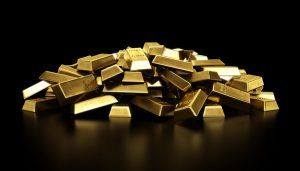
What is most interesting, however, is that the gold rally, and Dalio’s comments all have something to do with a man who died more than 400 years ago.
Sir Thomas Gresham (1519-1579) was a financier for Queen Elizabeth I of England. During Gresham’s service Henry VIII decided to alter the composition of the English shilling. In doing so, Henry substituted a major portion of the silver with ordinary base metals. Gresham took notice of what happened next. The spending public, aware of the change, responded by hoarding the older coins that predated the alteration. They wanted the silver.
By simply using the issue date on the coins, anyone could easily differentiate the coins with a high silver content from those that had a low proportion of silver. People stored the old coins and spent the new ones. Seeing this prompted Gresham to delineate “good” money from “bad.” In the case of the English shilling, people kept the coins that had more silver because they had the potential to eventually rise above their face value. This observation was later called Gresham’s Law and asserted that “bad money drives out good.” This brings us to gold, an example of “good” money.
Gold, unlike the dollar, has a value that is accepted worldwide. This inherent value makes gold unique. Many investors, like Dalio, are rediscovering this truth as they see money suffer from depreciation. Dalio explained that the attempts of central banks to stimulate asset prices are no longer as potent as they once were. He sees this characteristic as one that is so pervasive that he has called it a “paradigm shift.” In this new paradigm, debt, and non-debt liabilities will come due and many assets will not be valuable enough to fund these costs.
For these reasons many investors, not unlike the English that Gresham noticed, are choosing to own, and hold gold with the belief that it will rise in value over the long-term. Dalio concluded, “that it would be both risk-reducing and return-enhancing to consider adding gold to one’s portfolio.” Gold’s recent performance, and Dalio’s analysis are a reminder that certain economic principles endure despite ever changing technology, and the whims of the market.
For a long time, we have seen bad money drive out good. Experts like Dalio are taking opportunities today to get their hands on good money like gold.
The Coins Honoring Our Founding Father
Posted on — Leave a comment“Before there was a nation, before there was a symbol of this young nation — a flag, a constitution, a national seal — there was Washington. Even when in the course of revolutionary events a flag did appear and a Constitution, they did not have a long tradition behind them. But Washington was there, steadying the symbols, lending strength to them instead of drawing from them.” -Garry Wills

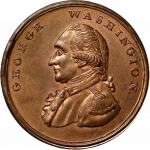
After a long, hard-fought Revolutionary war, the United States and Great Britain signed the Treaty of Paris in 1783. British troops finally left New York City in November, 1783 and in December George Washington resigned as Commander of the Revolutionary Army. America was free to chart its own course as an independent nation, no longer subject to the British monarchy.
Americans and many British sympathizers adored George Washington and wanted to pay homage to the man who wrested control of American away from the British and won freedom for his nation.
Born on February 22, 1732 in the state of Virginia, Washington was a Founding Father of the United States of America, a distinguished military commander who helped win the war by leading troops to significant victories against the British, and our nation’s first President.
“The ultimate significance of George Washington’s life lies in the fact that he singlehandedly redefined our traditional idea of greatness. To his everlasting credit, George Washington was ambiguous about power. The man who could have been king insisted that sovereignty lay with the people, however imperfect their judgment. At the end of the war and again at the end of his presidency, he calmly walked away from power.” – Richard Norton Smith
The Washington pieces were coined from 1783 through 1795 and quickly became popular with both British collectors and Americans. This category includes a variety of coins, tokens and medals, some were even produced in Britain, denominated with a half-penny or cent value.
Most of the high grade examples of each type that have survived were carefully preserved by British collectors. Meanwhile, the many well-worn surviving coins actually circulated in America.
Today, these colonial coins are all very rare and highly sought after by numismatics. Many included patriotic slogans and designs like eagles, shields, and stars, features that eventually were used on coins minted by the U.S. Mint.
Some, like the 1783 UNITY STATES and the 1793 Ship Halfpennies are fairly common. While others such as the Roman Head, dated 1783 and feature a left-facing bust of Washington wearing alternately a Roman toga or a military jacket are extremely rare and highlight sought after.
Collectors still actively seek out the 1791-dated copper tokens denominated ONE CENT. These tokens reveal a flattering and fairly accurate portrait of Washington facing left, dressed in a military jacket. There are two major types of the ONE CENT 1791 token, each display an eagle with a shield upon its breast. The first features the eagle with inverted wings, while the second and rarer type highlights a smaller eagle with its wings raised. Both show the eagle carrying an olive branch in its right claw and a bundle of arrows in its left.
Another popular item are brass tokens featuring the words “SUCCESS TO THE UNITED STATES” on their reverse. The tokens feature a right-facing bust of Washington, in military dress, and they are known in two sizes. Even today, they are generally discovered with little, if any wear, which implies these tokens were sold as souvenirs.
At Blanchard, we’re proud to offer our customers a fine selection of rare, historic coins. We’re confident we can help you find exactly what you’re looking for. Give us a call anytime!
Want to read more great coin stories? Sign up for our newsletter today!
A Man, A Plan, A Coin: The Oregon Trail Commemorative Coin
Posted on — Leave a commentFor many, the Oregon Trail evokes thoughts of untouched terrain, the untamed wild, and new beginnings. The reality was much different. Many lost their lives traveling the 2,170 miles spanning the distance of Kansas, Nebraska, Wyoming, Idaho, and Oregon. It is estimated that 20,000 people lie in unmarked graves. The journey was long, and the stakes were high. No one knew this better than Ezra Meeker.
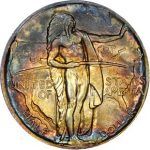
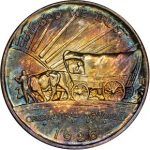
As a young man, Meeker traveled the Oregon trail by ox-drawn wagon. He began in Iowa and made his way to the Pacific coast. The journey was six months of hardship. Later, in his adult years he built his fortune growing hops for use in brewing beer. However, an aphid infestation in 1891 destroyed his crop and much of Meeker’s wealth with it. What followed were a series of attempts, largely unsuccessful, to rebuild his wealth.
In his later years he came to see that those who had risked their life on the trail, and those who died, were being forgotten. He resolved to restore the nation’s memory of the trail. As an old man in his late seventies he set out again by wagon to retrace the journey he made as a boy.
Meeker’s return to the trail did, in fact reinvigorate the nation’s resolve to commemorate the many who braved the journey. Many living in Idaho came to share Meeker’s interest in preserving the memory of the trail. Moreover, they wanted to preserve Fort Hall, a way station that had been part of the trail. Soon, the idea of an Oregon Trail commemorative coin became popular and Meeker became a driving force in making the project a reality.
In 1926 Washington Congressman John Franklin Miller introduced a bill authorizing the minting of the Oregon Trail Memorial half dollar. Eventually, Meeker testified before the House Coinage Committee. His influence was powerful and the bill passed with unanimous consent.
Officials selected the husband and wife team of James Fraser and Laura Gardin Fraser to create the look for the coin. The two had previously designed various coins for the US Mint. James sought to design one side of the coin while Laura designed the other. James’ design depicted a Conestoga wagon like so many seen on the trail during its early days. The image shows two oxen pulling the wagon with a blazing sunset in the distance. The five stars on the bottom of this side are believed to represent the five states and territories early Oregon Trail travelers would have traversed in their journey. The reverse side shows Laura’s design of a Native American with an outstretched arm gesturing peace.
By 1926 the Philadelphia Mint was ready to get to work. They struck 48,000 coins with Meeker anxiously standing by. He was eager to take the coins on the road and sell them for $1 each. Meeker’s plan was to use the proceeds from the sale to fund another commemorative project: historical markers along what used to be the Oregon trail. The coin became the first commemorative issue to be struck at more than one mint after the San Francisco Mint issued an additional 100,000 coins.
Meeker led a long and meaningful life reaching the age of 97. His last journey across portions of the trail was by plane in 1924. The pilot of those flights, Lt. Oakley G. Kelley, had earned the first nonstop transcontinental flight record just one year earlier when he flew from New York to San Diego without refueling. In 1928 the US Mint issued an additional 50,000 coins and another 17,000 in 1933.
Are you looking for a specific rare coin to add to your collection? We have a great selection and are always happy to help you find exactly what you need. Give us a call anytime!
Sign up for our newsletter and get more rare coin stories delivered straight to your email!








